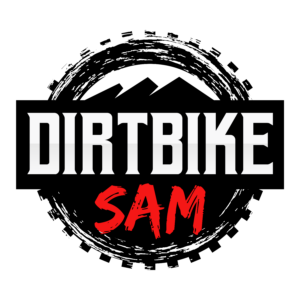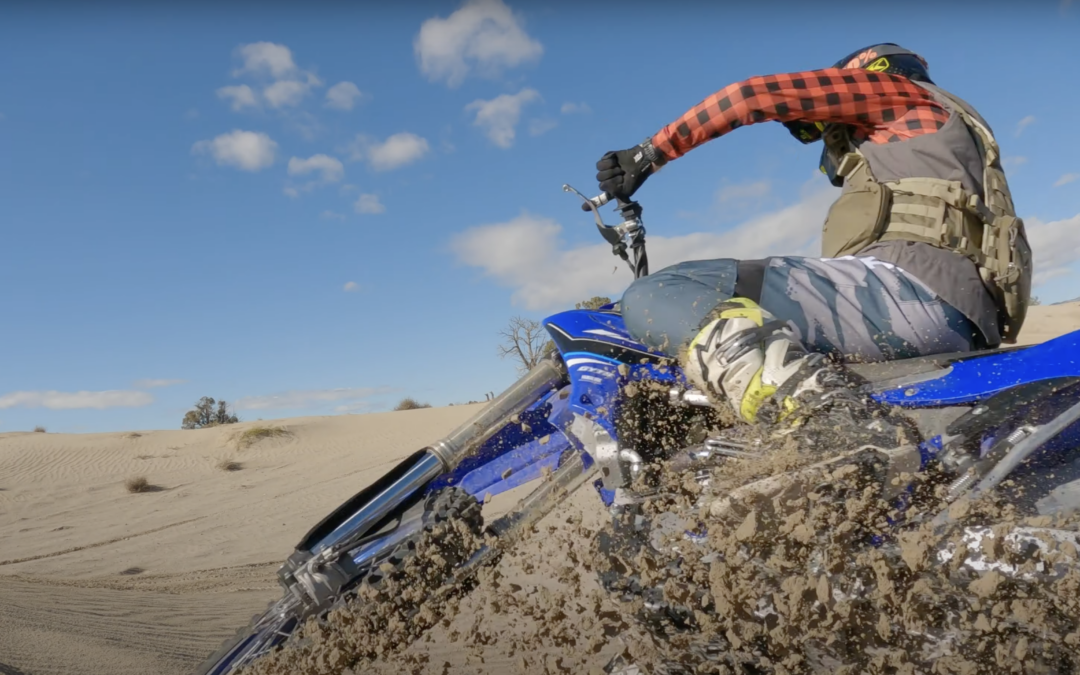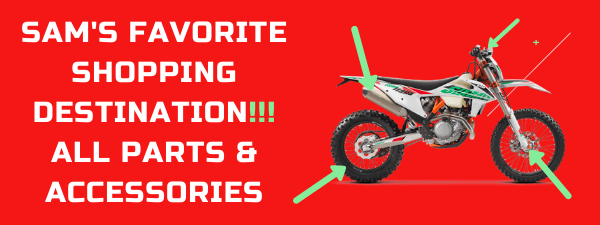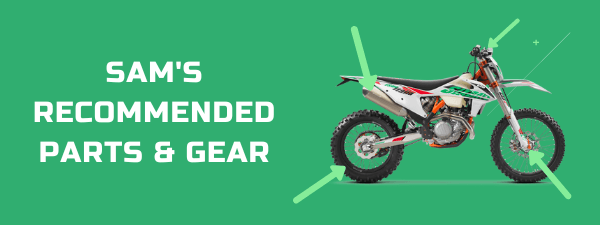This is a beginner’s guide on how to ride a dirt bike like a Pro.
We have all seen that one guy or watched the Pros race in supercross or motocross and have wondered how did they get so smooth and look so good on a dirt bike?
Have you ever wondered how to ride a dirt bike as the Pros do?
I know I have. Their form and technique really make it seem like the dirt bike and they are one.
There are DECADES of training the education that goes into training these Pros dirt bikers proper technique.
There are a couple of things to keep in mind when getting started into learning how to ride a dirt bike.
- Start Slowly
- Ride a bike that isn’t too powerful
- Use the correct technique
- PRACTICE
- Find a Mentor or someone who rides faster than you
Table of Contents
Importance of Proper Form When learning how to ride a dirt bike like a Pro
Correct dirt bike form is the cornerstone of professional racing techniques and maintaining control on and off the track. You do not want to be fighting with your dirt bike’s weight while racing or riding over rough off-road terrain.
Instead, you want to learn to move with it for a smoother, safer ride.
To do that, you need to know at least the basics of professional dirt bike positioning and form. If you are brand new to dirt bikes or are finally ready to to go pro, we have all the information you will need to get started.
Before any dirt bike race or event, it is a good idea to get to know whatever track you are going to be on dirt biking on. This is referred to as a ”track” walk.
It will not be enough to be familiar with your dirt bike.
Learning the track could mean the difference between winning and losing. This will also be a great time to learn how your competitors treat the track and where you might be able to eat up a little ground against them. Keeping your attention on the track, your dirt bike, and the way your body is positioned will make sure you are comfortable and able to focus during the actual event.
The type of dirt bike being ridden will influence the location of the center position. Modern dirt bike designs tend to have a steeper angle, so the weight of the rider will be centered much further forward to create a counterbalance when accelerating.
This is different from the builds of dirt bikes from even a generation ago. For all of the following information on positioning, we will assume that you are riding a newer generation dirt bike.
This article will explain step-by-step instructions on different aspects of riding a dirt bike in a professional setting. This includes how to position your body while standing up and sitting down.
The proper cornering techniques will also be addressed as corners are one of the make-or-break areas of any track and can be dangerous if you are new and unfamiliar with how to navigate them safely.
Find a Pro Dirt Bike Mentor
Ideally, you will also be watching other dirt bike riders and learning from their experience. The steps highlighted below will also need to be practiced frequently so that your body can learn to automatically position itself in the right way as you are riding.
Knowing the information will not be helpful if you do not work at creating a habit of keeping your riding form tight and professional.
Importance of Standing When Learning how to ride a dirt bike like a Pro
Standing up on a dirt bike affords the rider a better sense of balance and control. The weight transfer as your bike accelerates, decelerates, and contorts will be vital as the center of gravity moves with the action being performed.
You must be able to follow that center to keep the weight of the dirt bike and yourself balanced.
Being in a standing position allows quick movements and means you can quickly and easily center yourself forward or backward. Because the form of the modern dirt bike is quite steep, there is usually not a lot of time to make sure you keep your weight in the right spot. Tipping and getting thrown is not uncommon if you lose the center of gravity since your dirt bike itself is so heavy and in constant movement.
Practice standing up
Another reason that you want to stand when dirt bike riding is that it lessens overall muscle fatigue, so you can ride for longer when in this position. If you are brand new to dirt bikes, then it might feel a little weird to be standing, but the more you do it, the faster your body will acclimate, and it will increase the performance of handling and overall stamina.
For someone new to dirt biking in general or standing while riding, it can be easy to accidentally make steering or throttle mistakes without the proper form. Overcorrecting or having your foot slip off the pegs can happen if you are not making sure that you keep everything where it needs to be. It is recommended that you practice riding while standing off-road and on track to get used to the feel of it.
Legs act as suspension while dirt biking
The proper standing form is to balance with the balls of your feet on the foot begs to make sure they are not going to slip off and for ease of throttle use. Your body should be leaning forward slightly towards the handlebars with your knees slightly bent. You also want to make sure your elbows are bent somewhat rather than keeping them locked in place. Your head should be up with your eyes following the direction you want to be riding in while the clutch and brake should have only one or two fingers on the handlebars instead of the entire hand.
Grip the Dirt Bike with your Knees
The act of keeping your legs slightly bent helps to work as an added suspension and makes it simple to move from forward or backward as needed to maintain balance over jumps, on landings, around corners, and through the whoops. It is also a safety feature as it can keep your back from being jarred as much as it would be while standing with the knees locked in place.
It is also helpful to grip the dirt bike with your knees. This will keep a little space between yourself and your dirt bike, allowing them to move independently.
When is sitting down on your Dirt Bike Ok?
Once you get used to standing in this position, it can be easy to keep it up for a long time at a stretch making for a great time off-roading or on the track. Sitting back on the seat is useful when you want to gain traction as it adds more weight to the back tire. This can be useful when on flat, even terrain while accelerating or around tight corners. This position is rarely held for long on the track and mostly assists during cornering or on the straight lengths of the track when you can use the extra traction to gain on your fellow racers.
You should be familiar with riding while both sitting and standing so that you can move comfortably between the two according to the need of the moment. It is always safest when the rider can move smoothly between any position as needed to maintain their seat on the bike in any terrain and circumstances. It can also be useful to watch other professionals in videos or real life as they ride through off-road terrain and along tracks so you can catalog what choices they make and try them out for yourself to see how it feels.
Proper Torso Positioning When Accelerating on a Dirt Bike
While dirt riding, it is essential to make sure every part of your body is facing the right direction and held correctly. This will increase your ability to handle tight turns as well as quick speed increases and decreases. Your body positioning and posture will determine your dirt bike’s performance and balance. You want to keep your head up and facing whichever way you want the bike to move in, and this will keep your movement focused.
You will also want to check your dirt bike and make sure that it is set up for your specific body. You can adjust almost any part of the bike to make it closer or further away, so you want to make sure that you have the handlebars and pegs in a place where you can maintain proper torso positioning without straining or cramping your body. There are plenty of online videos that show you how to make these adjustments. The footpeg should be just in front of the foot arch. The handlebars should be within range to quickly move your torso over them in times of uphill acceleration.
The position of your upper torso is going to depend on a lot of factors, and you will need to be quite flexible with which direction and the degree you are leaning. For example, for a slow speed turn, you should tilt your torso to the outside edge of the dirt bike (example: if you are turning right, lean your body slightly left) to counterbalance the movement so that you do not make the turn too sharp and overbalance into the corner.
Leaning forward so that your chest is over the handlebars will allow for creating better steering when you are accelerating up hills and will also keep your center of gravity neutral so that you can easily follow the angle upward and then when you get to the top roll your center backward by leaning slightly back from the handlebars. When going cross-slope or when moving diagonally across a hill you want to make sure your weight is shifted somewhat towards the down peg (example: if you are riding horizontally across a slope leading up to your right your weight will be focus slightly left and down) as this will keep your wheels from losing grip and slipping down the gradient.
The legs will be moving over the dirt bike repeatedly both near the ankle because your feet are moving so much to change gears and around the knee area since you will move them forward and backward depending on whether you are sitting or standing for any given stretch of the track. To keep this movement smooth, it can be helpful to create your own plate of material to place there, which can be glued or attached in some other way to the tank. There are tutorials online on how to do this and which ones different professionals prefer. While you do not want to be death gripping the tank, it will be necessary to use it during hard accelerations and decelerations.
Your hips, when seated, should be angled forward and up instead of slouched back. This will help keep your legs and back tight, and moving between sitting and standing will be faster. It will also create less wear on the body. The hips should also be in alignment with the shoulder as far as which direction you are leaning, left or right, to keep the center of balance. Your core abdominal muscles should be engaged as well when sitting so that you maintain the correct posture and protect your back from getting too strained. Generally, sitting will take place when accelerating or hard movements.
Proper Torso Positioning When Decelerating on a Dirt Bike
When downshifting do not take your foot off the peg as this can cause control issues if you hit a patch of uneven ground. Instead, pivot your ankle to achieve the correct angle to downshift. You will also want to be standing because there can sometimes be an abrupt jolt when downshifting that can throw your balance a bit unless you are ready for it, and standing affords the flexibility for movement.
Stopping power comes from the FRONT BRAKE
You want to practice braking with both the front and rear brakes because they can be very different, and your position will need to change based on speed and which brake you are choosing to use. For example, the front brake tends to grip the ground more firmly when braking and could potentially lock up if you are not familiar with it. When decelerating, you use the balls of your feet to manipulate the back brake and sit or stand slightly forward. Hold yourself in place by hugging the dirt bike with your knees to keep yourself from sliding around too much.
When using either the front or back brake, the main thing to remember is to be smooth and controlled in the movement. Do not jerk the brakes or use them abruptly as this will often completely throw off your center of gravity and send you either off the front of the bike or topple the bike altogether. Get familiar with braking, practice both forms and do it at various speeds, all while maintaining smooth control of the brakes. This will make it more comfortable during races and events when you might need to make spur of the moment decisions or decelerate quickly to avoid a collision.
Proper Arm and Shoulder Positioning while riding a Dirt Bike
Keep your arms relaxed and your elbows up. The more strain you put on them, the faster your body will get exhausted. It will also be easier to overcorrect and cause steering problems if you are too tense. Keep them loose and easily moving with the bike as you move your body forward and backward over different terrain.
AVOID ARM PUMP
You will want to work on upper body strength so that your shoulders and arms do not tire out too quickly. Weight training, swimming, and rowing are the best exercises for keeping the necessary strength level in this area of your body. It is highly recommended that you do a few warm-up activities for your upper body before you race or go out on an off-road ride because this will get the blood flowing and prepare your muscles for the strain to come.
Stay Hydrated while Dirt Biking and training
Hydration, especially during drawn-out events, is critical because dehydrating can cause cramps in your arm or shoulder muscles, and having that happen in the middle of a race can be dangerous for yourself and other riders. Be aware of how much you are drinking and keep your electrolytes up. Staying on top of your health will be very important when it comes to being capable of maintaining the correct arm and shoulder form for long periods.
Your content goes here. Edit or remove this text inline or in the module Content settings. You can also style every aspect of this content in the module Design settings and even apply custom CSS to this text in the module Advanced settings.


How To Corner on a Dirt Bike Like a Pro
Proper cornering can mean the difference between falling behind the pack or pulling ahead. As you pull into a corner, allow your body to move forward slightly and find the center of gravity.
Jump for show and corner for dough!
This will help stabilize you and the dirt bike as you turn. Always follow the corner with your body; your body should be leading the bike instead of the other way around. Instead of turning sharply with the handlebars, use your body weight and the bike’s weight to help with putting pressure on the handlebars in the direction you want to be turning. This will give you greater control of the movement.
Weight the outside peg on the Dirt Bike
If you are seated, then you will want to slow down as you come into the corner, keep your elbows up, and make sure your inside foot is up with the toes pointed up as well to keep it from grabbing the dirt and pulling the bike. Once you are coming out of the corner, that is the best time to accelerate, but you want to make sure you do it smoothly because if you gun it, then there can be a jolt that may cause a loss of control.
Smooth, steady acceleration is the best way to come out of a corner without losing any speed.
LOOK WHERE YOU WANT TO GO – Not at the Rut.
When going through a corner while standing, you want to lean slightly forward the same as you would while sitting. Still, you want to lean a bit more of your weight on the inside footpeg to keep the bike weighted that direction (example: if you are turning left, put a bit more pressure on the left footpeg) because this will keep your bike moving smoothly in the direction that you want for proper cornering.
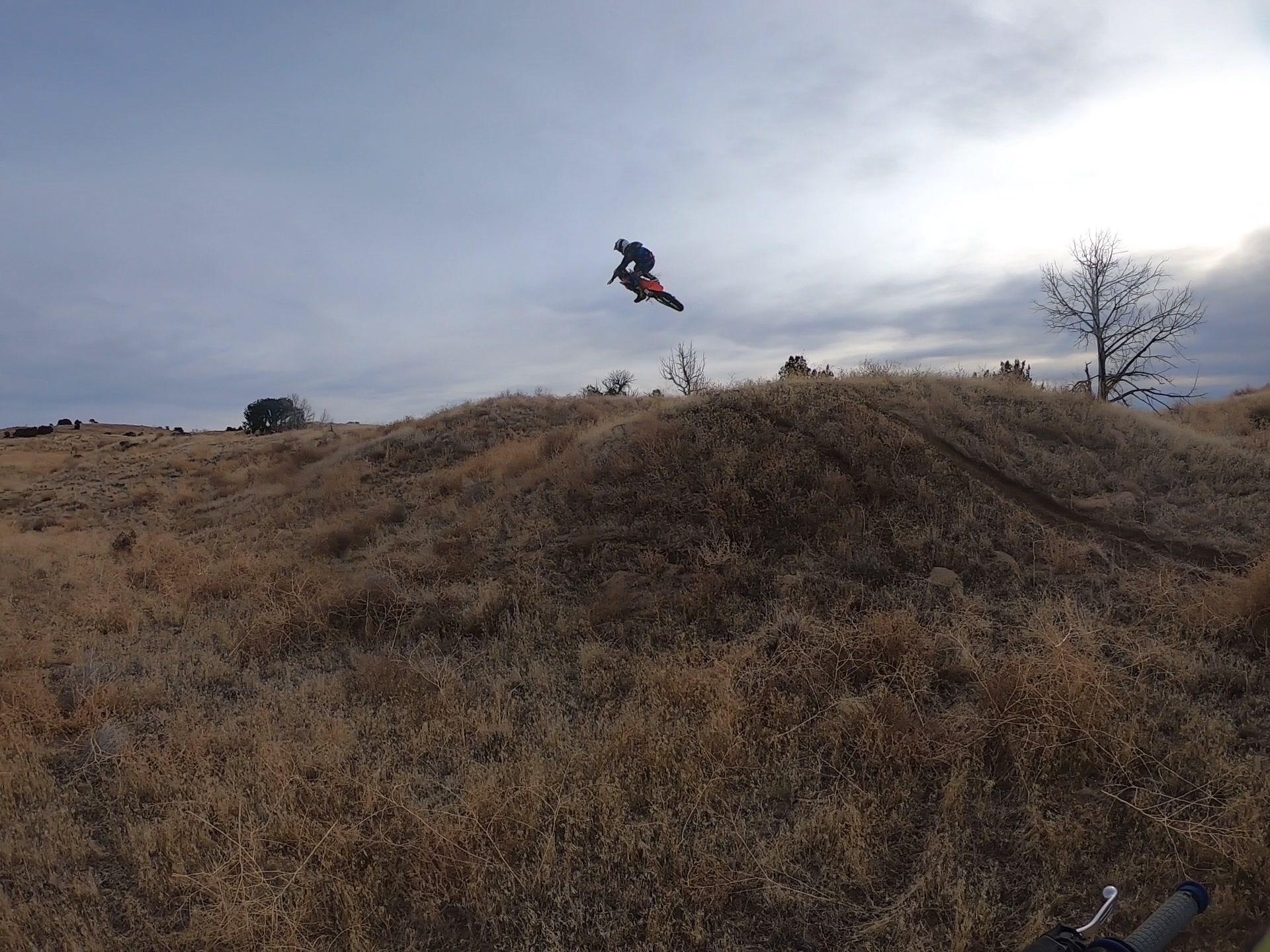
Best Form for Jump a Dirt Bike like a PRO
There are a few different ways to approach a jump depending on the terrain, angle, and speed. If you are jumping over natural bumps and hills versus a track or ramp there are different positions you can be in and ways to hold your body to keep the best control over your dirt bike, direction, and landing.
Correct posture is vital for a solid take-off and landing, but before you even get to that point you need to be familiar with the jump itself. Whenever possible it is best to either walk over or ride very slowly over the jump so that you can see the best path through it and find your line of sight that you will follow to keep your bike aimed properly. If you can, try watching someone else take the jump at normal speed so you can get an idea of how fast to approach it.
The size of most track jumps is going to be between four to six feet high. Due to the speeds and heights involved, when you are new to jumping make sure to always wear full protective gear. A few spills will be inevitable until you get the hang of it so you want to be as prepared and safe as possible. Learning how to roll into a fall can also help if you end up getting thrown.
Once you ready to take the jump at speed be sure your dirt bike is not cold. You do not want to go straight into a jump without warming up the bike otherwise you run the risk of having engine difficulties that might lead to you losing control and that is always dangerous when jumps are involved. A few laps or revving the engine to warm it up should be sufficient.
Once you feel comfortable jumping your dirt bike you can follow faster dirt bike riders off bigger jumps to match their speed in order to clear a bigger dirt bike jump.
Read in more details about how to properly jump a dirt bike.
Follow a faster dirt bike rider off a jump to match their speed
When taking a jump you should be standing with your body at roughly a forty-five-degree angle to the ground with your knees bent and hugging the bike for stability. Your mass should be centered on the bike with your hips above the footpegs, elbows held up and out. As always, keep your eyes on where you want the bike to go not on the jump or the wheel of the bike.
Accelerate on your way up the jump smoothly in a low gear, keeping it going through the jump. Gun the throttle if you find the bike pitching too far forward and engage the brake gently before the landing if you will be landing on the back wheel. If you are moving very quickly it is best to use your weight to balance the bike so that it will land on both wheels so that it will be easier to control the landing. Keep your knees hugging tightly on the dirt bike for the landing to keep your seat.
Remember, Pro dirt bike racers practice a lot! This is their full-time gig and they train and train. You won’t be able to ride like a pro in one day. It will take years and years of practice to be able to ride as the professional riders do.
That’s ok, break it down.
Focus on 1 thing that you want to work on. Do this every ride and you will get better and better.
The more you also ride or race your dirt bike the more in shape your body will be.
Also, remember its the RIDER not the dirt bike. All the pro riders that I have had the privilege of riding with could ride any dirt bike very well and very fast.
